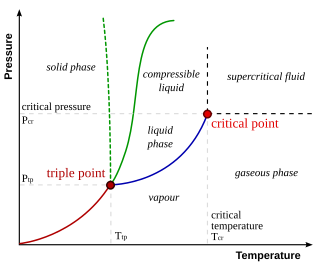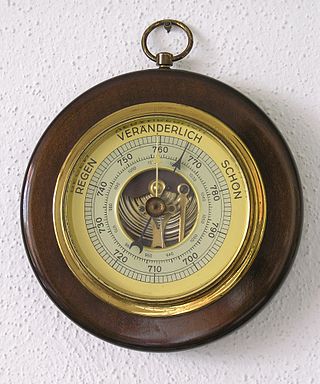Related Research Articles

The boiling point of a substance is the temperature at which the vapor pressure of a liquid equals the pressure surrounding the liquid and the liquid changes into a vapor.

The litre or liter is a metric unit of volume. It is equal to 1 cubic decimetre (dm3), 1000 cubic centimetres (cm3) or 0.001 cubic metres (m3). A cubic decimetre occupies a volume of 10 cm × 10 cm × 10 cm and is thus equal to one-thousandth of a cubic metre.

In thermodynamics, the triple point of a substance is the temperature and pressure at which the three phases of that substance coexist in thermodynamic equilibrium. It is that temperature and pressure at which the sublimation, fusion, and vaporisation curves meet. For example, the triple point of mercury occurs at a temperature of −38.8 °C (−37.8 °F) and a pressure of 0.165 mPa.
Atmospheric pressure, also known as air pressure or barometric pressure, is the pressure within the atmosphere of Earth. The standard atmosphere is a unit of pressure defined as 101,325 Pa (1,013.25 hPa), which is equivalent to 1,013.25 millibars, 760 mm Hg, 29.9212 inches Hg, or 14.696 psi. The atm unit is roughly equivalent to the mean sea-level atmospheric pressure on Earth; that is, the Earth's atmospheric pressure at sea level is approximately 1 atm.
In chemistry and thermodynamics, the standard enthalpy of formation or standard heat of formation of a compound is the change of enthalpy during the formation of 1 mole of the substance from its constituent elements in their reference state, with all substances in their standard states. The standard pressure value p⦵ = 105 Pa(= 100 kPa = 1 bar) is recommended by IUPAC, although prior to 1982 the value 1.00 atm (101.325 kPa) was used. There is no standard temperature. Its symbol is ΔfH⦵. The superscript Plimsoll on this symbol indicates that the process has occurred under standard conditions at the specified temperature (usually 25 °C or 298.15 K).

The pascal is the unit of pressure in the International System of Units (SI). It is also used to quantify internal pressure, stress, Young's modulus, and ultimate tensile strength. The unit, named after Blaise Pascal, is an SI coherent derived unit defined as one newton per square metre (N/m2). It is also equivalent to 10 barye in the CGS system. Common multiple units of the pascal are the hectopascal, which is equal to one millibar, and the kilopascal, which is equal to one centibar.
In chemistry and related fields, the molar volume, symbol Vm, or of a substance is the ratio of the volume (V) occupied by a substance to the amount of substance (n), usually at a given temperature and pressure. It is also equal to the molar mass (M) divided by the mass density (ρ):
In physical chemistry, Henry's law is a gas law that states that the amount of dissolved gas in a liquid is directly proportional at equilibrium to its partial pressure above the liquid. The proportionality factor is called Henry's law constant. It was formulated by the English chemist William Henry, who studied the topic in the early 19th century. In simple words, we can say that the partial pressure of a gas in vapour phase is directly proportional to the mole fraction of a gas in solution.
Avogadro's law or Avogadro-Ampère's hypothesis is an experimental gas law relating the volume of a gas to the amount of substance of gas present. The law is a specific case of the ideal gas law. A modern statement is:
Avogadro's law states that "equal volumes of all gases, at the same temperature and pressure, have the same number of molecules."
For a given mass of an ideal gas, the volume and amount (moles) of the gas are directly proportional if the temperature and pressure are constant.
The standard state of a material is a reference point used to calculate its properties under different conditions. A degree sign (°) or a superscript Plimsoll symbol (⦵) is used to designate a thermodynamic quantity in the standard state, such as change in enthalpy (ΔH°), change in entropy (ΔS°), or change in Gibbs free energy (ΔG°). The degree symbol has become widespread, although the Plimsoll is recommended in standards, see discussion about typesetting below.

The standard atmosphere is a unit of pressure defined as 101325 Pa. It is sometimes used as a reference pressure or standard pressure. It is approximately equal to Earth's average atmospheric pressure at sea level.

The International Standard Atmosphere (ISA) is a static atmospheric model of how the pressure, temperature, density, and viscosity of the Earth's atmosphere change over a wide range of altitudes or elevations. It has been established to provide a common reference for temperature and pressure and consists of tables of values at various altitudes, plus some formulas by which those values were derived. The International Organization for Standardization (ISO) publishes the ISA as an international standard, ISO 2533:1975. Other standards organizations, such as the International Civil Aviation Organization (ICAO) and the United States Government, publish extensions or subsets of the same atmospheric model under their own standards-making authority.
This page provides supplementary data to the article properties of water.
A standard cubic foot (scf) is a unit representing the amount of gas (such as natural gas) contained in a volume of one cubic foot at reference temperature and pressure conditions. It is the unit commonly used when following the customary system, a collection of standards set by the National Institute of Standards and Technology. Another unit used for the same purpose is the standard cubic metre (Sm3), derived from SI units, representing the amount of gas contained in a volume of one cubic meter at different reference conditions. The reference conditions depend on the type of gas and differ from other standard temperature and pressure conditions.
Standard cubic feet per minute (SCFM) is the molar flow rate of a gas expressed as a volumetric flow at a "standardized" temperature and pressure thus representing a fixed number of moles of gas regardless of composition and actual flow conditions. It is related to the mass flow rate of the gas by a multiplicative constant which depends only on the molecular weight of the gas. There are different standard conditions for temperature and pressure, so care is taken when choosing a particular standard value. Worldwide, the "standard" condition for pressure is variously defined as an absolute pressure of 101,325 pascals, 1.0 bar, 14.73 psia, or 14.696 psia and the "standard" temperature is variously defined as 68 °F, 60 °F, 0 °C, 15 °C, 20 °C, or 25 °C. The relative humidity is also included in some definitions of standard conditions.
An amagat is a practical unit of volumetric number density. Although it can be applied to any substance at any conditions, it is defined as the number of ideal gas molecules per unit volume at 1 atm (101.325 kPa) and 0 °C (273.15 K). It is named after Émile Amagat, who also has Amagat's law named after him.

The U.S. Standard Atmosphere is a static atmospheric model of how the pressure, temperature, density, and viscosity of the Earth's atmosphere change over a wide range of altitudes or elevations. The model, based on an existing international standard, was first published in 1958 by the U.S. Committee on Extension to the Standard Atmosphere, and was updated in 1962, 1966, and 1976. It is largely consistent in methodology with the International Standard Atmosphere, differing mainly in the assumed temperature distribution at higher altitudes.
Base conditions, also known as standard conditions, consist of a specified absolute pressure and temperature. To ensure accuracy, it is important to refer to base conditions when measuring the volume of a sample of liquid or gas. This applies to both static measurement and flow measurement.
Several units of volume are used in petroleum engineering.
The standard liter per minute is a unit of mass flow rate of a gas at standard conditions for temperature and pressure (STP), which is most commonly practiced in the United States, whereas European practice revolves around the normal litre per minute (NLPM). Until 1982, STP was defined as a temperature of 273.15 K and an absolute pressure of 101.325 kPa (1 atm). Since 1982, STP is defined as a temperature of 273.15 K and an absolute pressure of 100 kPa (1 bar).
References
- 1 2 3 A. D. McNaught and A. Wilkinson (1997). Nič, Miloslav; Jirát, Jiří; Košata, Bedřich; Jenkins, Aubrey; McNaught, Alan (eds.). IUPAC. Compendium of Chemical Terminology (PDF) (2nd ed.). Oxford: Blackwell Scientific Publications. p. 54. doi:10.1351/goldbook. ISBN 0-632-03583-8.
Standard conditions for gases: ... and pressure of 105 pascals. The previous standard absolute pressure of 1 atm (equivalent to 101.325 kPa) was changed to 100 kPa in 1982. IUPAC recommends that the former pressure should be discontinued.
- 1 2 A. D. McNaught and A. Wilkinson (1997). "standard pressure". IUPAC. Compendium of Chemical Terminology (2nd ed.). Oxford: Blackwell Scientific Publications. doi:10.1351/goldbook.S05921. ISBN 978-0-9678550-9-7.
- ↑ Doiron, Theodore D. (January 2007). "20 Degrees Celsius--A Short History of the Standard Reference Temperature for Industrial Dimensional Measurements". NIST. 112 (1): 1–23. doi:10.6028/jres.112.001. PMC 4654601 . PMID 27110451.
- ↑ Helrich, Carl S. (2008-11-14). Modern Thermodynamics with Statistical Mechanics. Springer Science & Business Media. ISBN 978-3-540-85418-0.
- ↑ "A Guide to the NIST Chemistry WebBook". webbook.nist.gov. Retrieved 2020-10-06.
- ↑ "Specifications, Tolerances, and Other Technical Requirements for Weighing and Measuring Devices" (PDF). p. 3-1.
- 1 2 Natural gas – Standard reference conditions (ISO 13443). Geneva, Switzerland: International Organization for Standardization. 1996.
- ↑ API Petroleum Measurement
- ↑ Doiron, Ted (Jan–Feb 2007). "20 °C – A Short History of the Standard Reference Temperature for Industrial Dimensional Measurements". Journal of Research of the National Institute of Standards and Technology. 112 (1): 1–23. doi:10.6028/jres.112.001. PMC 4654601 . PMID 27110451.
- ↑ Cohen, Joel E.; Small, Christopher (November 24, 1998). "Hypsographic demography: The distribution of human population by altitude". Proceedings of the National Academy of Sciences. 95 (24): 14009–14014. Bibcode:1998PNAS...9514009C. doi: 10.1073/pnas.95.24.14009 . PMC 24316 . PMID 9826643.
- ↑ Gassco. "Concepts – Standard cubic meter (scm)". Archived from the original on October 18, 2007. Retrieved 2008-07-25.
Scm: The usual abbreviation for standard cubic metre – a cubic metre of gas under a standard condition, defined as an atmospheric pressure of 1.01325 bar and a temperature of 15°C. This unit provides a measure for gas volume.
- ↑ Nord Stream (October 2007). "Status of the Nord Stream pipeline route in the Baltic Sea" (PDF). Archived from the original (PDF) on 2008-02-16. Retrieved 2008-07-25.
bcm: Billion Cubic Meter (standard cubic metre – a cubic metre of gas under a standard condition, defined as an atmospheric pressure of 1 atm and a temperature of 15 °C.)
- ↑ Metrogas (June 2004). "Natural gas purchase and sale agreement" . Retrieved 2008-07-25.
Natural gas at standard condition shall mean the quantity of natural gas, which at a temperature of fifteen (15) Celsius degrees and a pressure of 101.325 kilopascals occupies the volume of one (1) cubic meter.
- ↑ NIST (1989). "NIST Standard Reference Database 124 – Stopping-Power and Range Tables for Electrons, Protons, and Helium Ions". Archived from the original on October 6, 2010. Retrieved 2008-07-25.
If you want the program to treat the material as an ideal gas, the density will be assumed given by M/V, where M is the gram molecular weight of the gas and V is the mol volume of 22414 cm3 at standard conditions (0 deg C and 1 atm).
- ↑ ISO (1994). "ISO 10780:1994 : Stationary source emissions – Measurement of velocity and volume flowrate of gas streams in ducts".
- ↑ Robert C. Weast, ed. (1975). Handbook of Physics and Chemistry (56th ed.). CRC Press. pp. F201–F206. ISBN 978-0-87819-455-1.
- ↑ Extraction, First Treatment and Loading of Liquid & Gaseous Fossil Fuels (Emission Inventory Guidebook B521, Activities 050201 – 050303) (PDF). Copenhagen, Denmark: European Environmental Agency. September 1999.
- 1 2 "Electricity and Gas Inspection Act", SOR/86-131 (defines a set of standard conditions for Imperial units and a different set for metric units) Canadian Laws.
- ↑ "Standards of Performance for New Sources", 40 CFR—Protection of the Environment, Chapter I, Part 60, Section 60.2, 1990.
- ↑ Wright, J. D.; Johnson, A. N.; Moldover, M. R. (2003). "Design and Uncertainty for a PVTt Gas Flow Standard" (PDF). Journal of Research of the National Institute of Standards and Technology. 108 (1): 21–47. doi:10.6028/jres.108.004. PMC 4844527 . PMID 27413592. Archived from the original (PDF) on 2004-07-21.
- ↑ (Also called NTP, Normal Temperature and Pressure.)
- ↑ "What is the difference between STP and NTP?". Socratic. Archived from the original on 2015-11-27. Retrieved 2018-08-28.
- ↑ Almond, Peter R.; Biggs, Peter J.; Coursey, B. M.; Hanson, W. F.; Huq, M. Saiful; Nath, Ravinder; Rogers, D. W. O. (1999). "AAPM's TG-51 protocol for clinical reference dosimetry of high-energy photon and electron beams". Medical Physics. 26 (9): 1847–1870. Bibcode:1999MedPh..26.1847A. doi: 10.1118/1.598691 . PMID 10505874. S2CID 12687636.
- ↑ "CRC Handbook of Chemistry and Physics", Definition of Ambient, Chapter 1-26, 95th Edition, William M. Haynes, ed., CRC Press, Boca Raton, FL, 2014.
- ↑ "National Primary and Secondary Ambient Air Quality Standards", 40 CFR—Protection of the Environment, Chapter I, Part 50, Section 50.3, 1998.
- ↑ "Glossary". Cleveland, OH, US: Compressed Air and Gas Institute. 2002. Archived from the original on 2007-09-02.
- 1 2 "The SI Metric System of Units and SPE Metric Standard (1982)" (PDF). Society of Petroleum Engineers. Standard Temperature (Page 24), and Notes for Table 2.3, (on PDF page 25 of 42 PDF pages), define two different sets of reference conditions, one for the standard cubic foot and one for the standard cubic meter.
- ↑ Air Intake Filters (ISO 5011:2002). Geneva, Switzerland: International Organization for Standardization. 2002.
- ↑ "Storage and Handling of Liquefied Petroleum Gases" and "Storage and Handling of Anhydrous Ammonia", 29 CFR—Labor, Chapter XVII—Occupational Safety and Health Administration, Part 1910, Sect. 1910.110 and 1910.111, 1993 Storage/Handling of LPG.
- ↑ "Rule 102, Definition of Terms (Standard Conditions)", Amended December 2004, South Coast Air Quality Management District, Los Angeles, California, US SCAQMD Rule 102
- ↑ "49 C.F.R. § 171" . Retrieved 22 May 2018.
- ↑ Sierra Bullets. "Chapter 3 – Effects of Altitude and Atmospheric Conditions (Exterior Ballistics Section)". Rifle and Handgun Reloading Manual (5 ed.). Sedalia, MO, US. Archived from the original on 2006-03-09. Retrieved 2006-02-03.
- ↑ Gas turbines – Acceptance tests (ISO 2314:2009) (2 ed.). Geneva, Switzerland: International Organization for Standardization. 2009.
- ↑ Gas turbines – Procurement – Part 2: Standard reference conditions and ratings (ISO 3977-2:1997). Geneva, Switzerland: International Organization for Standardization. 1997.
- ↑ "ASHRAE Handbook Online". www.ashrae.org. Retrieved 2023-08-09.
- ↑ ANSI/AMCA Standard 210, "Laboratory Methods Of Testing Fans for Aerodynamic Performance Rating", as implied by http://www.greenheck.com/pdf/centrifugal/Plug.pdf when accessed on October 17, 2007.
- ↑ This AMCA standard applies only to air; Compressed Gas Association [CGA] applies to industrial gas use in US.
- ↑ Association, Compressed Gas (2012-12-06). Compressed Gas Handbook. Springer. ISBN 9781461306733 . Retrieved 22 Nov 2017.
- ↑ Pilot's Handbook of Aeronautical Knowledge (PDF). U.S. Department of Transportation Federal Aviation Administration. 2016. p. 4-3.
- ↑ Air Conditioners, liquid chilling packages and heat pumps with electrically driven compressors for space heating and cooling. UK: BSI EN. 2013.
- ↑ Standard Atmosphere. Geneva, Switzerland: International Organization for Standardization. 1975.
- ↑ Natural gas - Standard reference conditions. Geneva, Switzerland: International Organization for Standardization. 1996.
- ↑ Gas analysis - Vocabulary. Geneva, Switzerland: International Organization for Standardization. 2015.
- ↑ Referenzzustand, Normzustand, Normvolumen; Begriffe und Werte. Germany: Deutsches Institut für Normung. 1990.
- ↑ Auld, D.J.; Srinivas, K. (2008). "Properties of the Atmosphere". Archived from the original on 2013-06-09. Retrieved 2008-03-13.
- ↑ Batchelor, G. K., An Introduction to Fluid Dynamics, Cambridge Univ. Press, 1967.
- ↑ Peter Gribbon (2001). Excel HSC Chemistry Pocket Book Years 11–12. Pascal Press. ISBN 978-1-74020-303-6.
- ↑ "Fundamental Physical Properties: Molar Volumes (CODATA values for ideal gases)". NIST.
- ↑ U.S. Standard Atmosphere, 1976, U.S. Government Printing Office, Washington, D.C., 1976.